Contemporary Accounting Issues in Qantas and Virgin Airlines Analysis
VerifiedAdded on 2020/03/13
|17
|2306
|169
Report
AI Summary
This report provides a comprehensive analysis of the contemporary accounting issues within Qantas Airways and Virgin Australia Airlines. It examines the companies' compliance with the Australian Accounting Standards Board (AASB) and the Corporations Act 2001, focusing on their adherence to the conceptual framework and the application of the prudence theory in financial reporting. The report delves into the criteria used for financial data, including tangible and intangible assets, depreciation methods, and revenue recognition. Furthermore, it evaluates the rationale for shareholders investing in these companies, highlighting key financial indicators such as revenue, operating expenditure, and profit before tax (PBT). The analysis considers the financial statements, annual reports, and CEO statements to provide insights into the companies' financial performance and investment potential. The report concludes by summarizing the key findings and emphasizing the factors that make Qantas a potentially more attractive investment compared to Virgin Australia. The report uses the latest financial data and accounting standards to provide a detailed overview of the accounting practices of the two airlines.
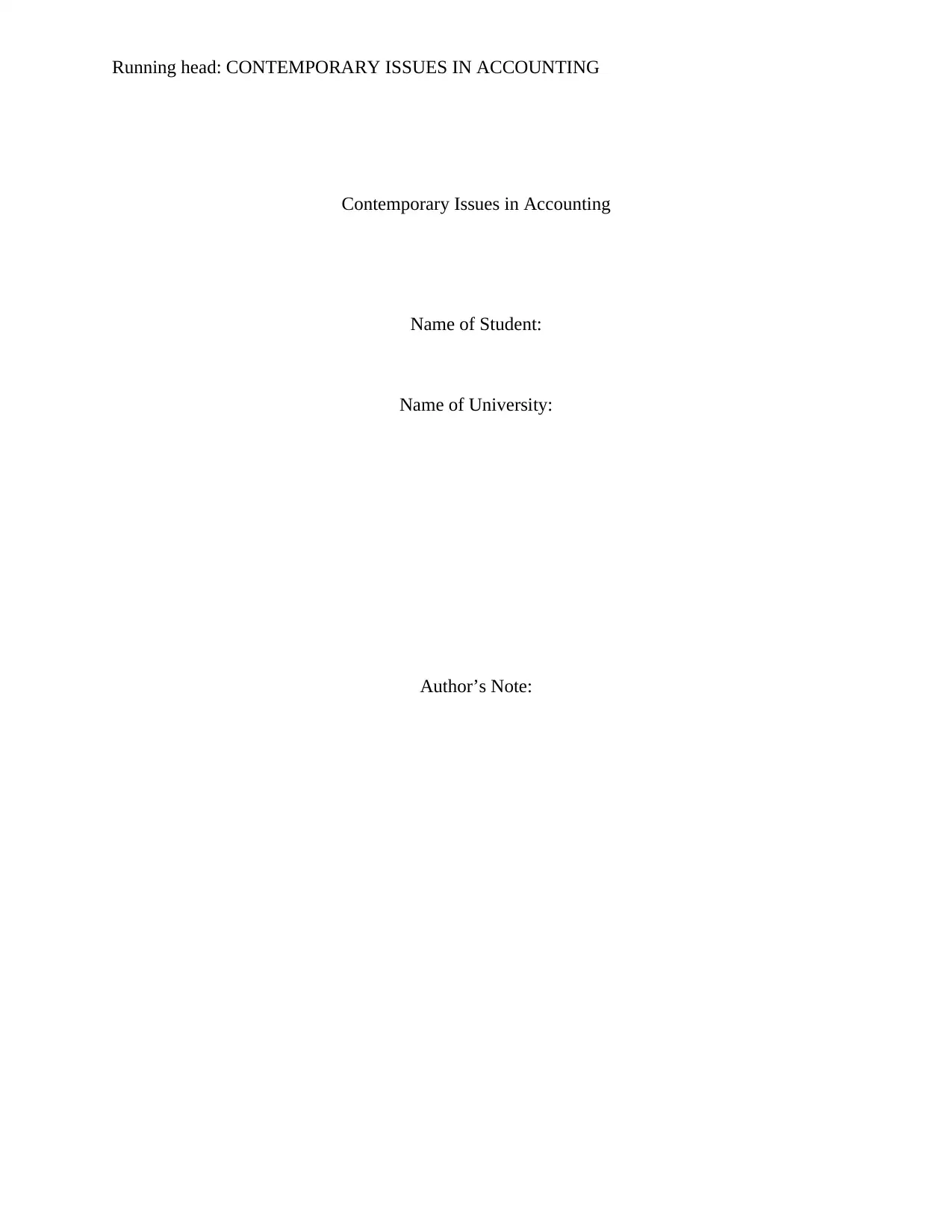
Running head: CONTEMPORARY ISSUES IN ACCOUNTING
Contemporary Issues in Accounting
Name of Student:
Name of University:
Author’s Note:
Contemporary Issues in Accounting
Name of Student:
Name of University:
Author’s Note:
Paraphrase This Document
Need a fresh take? Get an instant paraphrase of this document with our AI Paraphraser
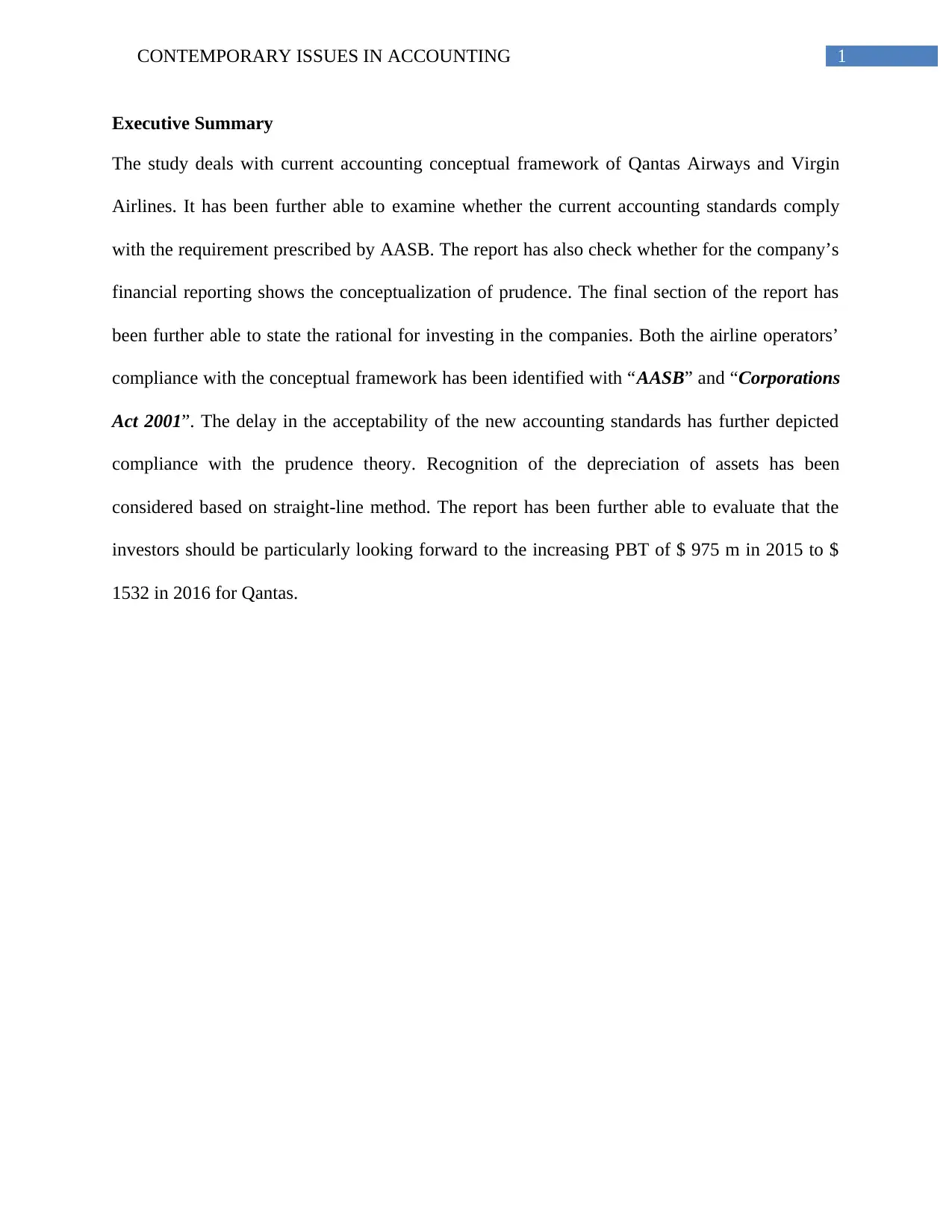
1CONTEMPORARY ISSUES IN ACCOUNTING
Executive Summary
The study deals with current accounting conceptual framework of Qantas Airways and Virgin
Airlines. It has been further able to examine whether the current accounting standards comply
with the requirement prescribed by AASB. The report has also check whether for the company’s
financial reporting shows the conceptualization of prudence. The final section of the report has
been further able to state the rational for investing in the companies. Both the airline operators’
compliance with the conceptual framework has been identified with “AASB” and “Corporations
Act 2001”. The delay in the acceptability of the new accounting standards has further depicted
compliance with the prudence theory. Recognition of the depreciation of assets has been
considered based on straight-line method. The report has been further able to evaluate that the
investors should be particularly looking forward to the increasing PBT of $ 975 m in 2015 to $
1532 in 2016 for Qantas.
Executive Summary
The study deals with current accounting conceptual framework of Qantas Airways and Virgin
Airlines. It has been further able to examine whether the current accounting standards comply
with the requirement prescribed by AASB. The report has also check whether for the company’s
financial reporting shows the conceptualization of prudence. The final section of the report has
been further able to state the rational for investing in the companies. Both the airline operators’
compliance with the conceptual framework has been identified with “AASB” and “Corporations
Act 2001”. The delay in the acceptability of the new accounting standards has further depicted
compliance with the prudence theory. Recognition of the depreciation of assets has been
considered based on straight-line method. The report has been further able to evaluate that the
investors should be particularly looking forward to the increasing PBT of $ 975 m in 2015 to $
1532 in 2016 for Qantas.
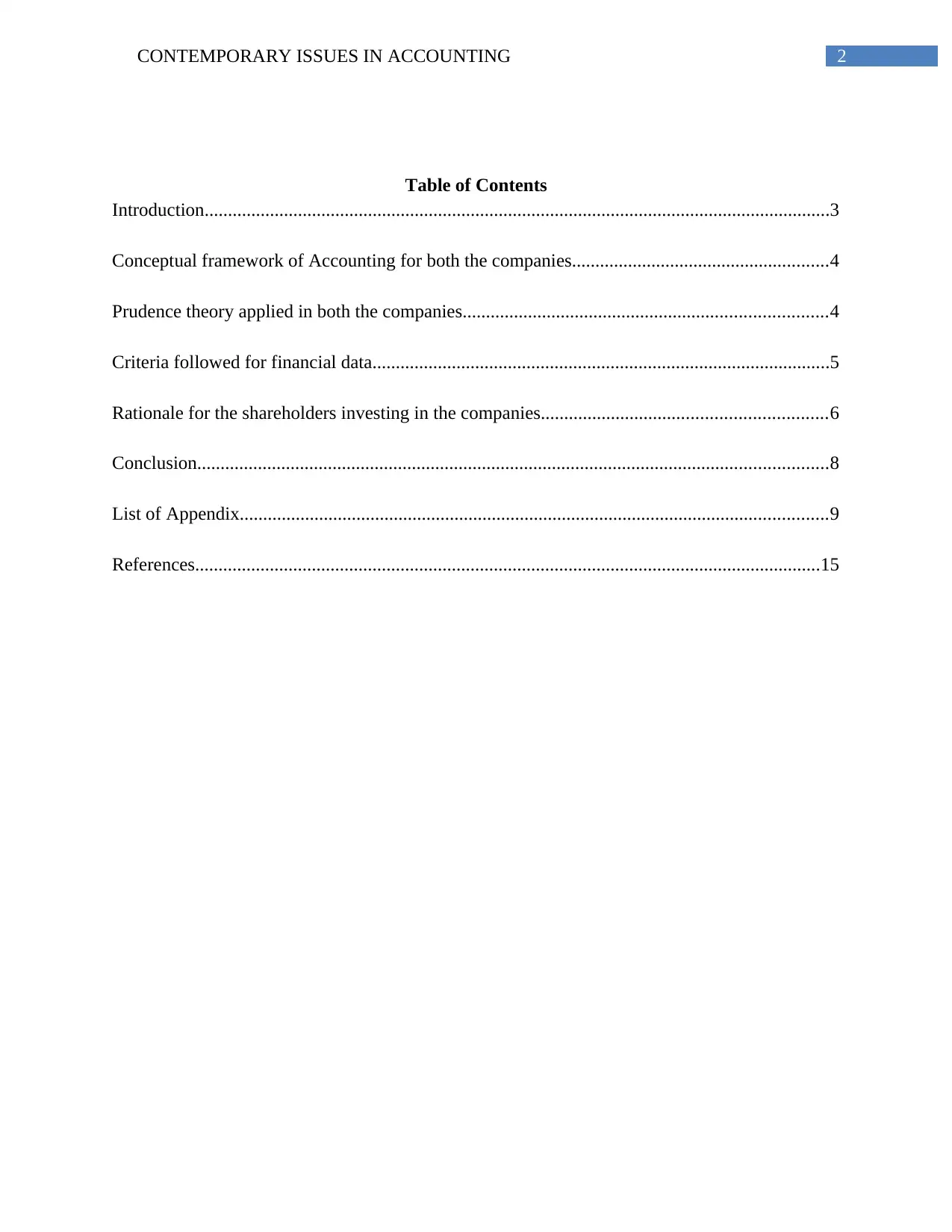
2CONTEMPORARY ISSUES IN ACCOUNTING
Table of Contents
Introduction......................................................................................................................................3
Conceptual framework of Accounting for both the companies.......................................................4
Prudence theory applied in both the companies..............................................................................4
Criteria followed for financial data..................................................................................................5
Rationale for the shareholders investing in the companies.............................................................6
Conclusion.......................................................................................................................................8
List of Appendix..............................................................................................................................9
References......................................................................................................................................15
Table of Contents
Introduction......................................................................................................................................3
Conceptual framework of Accounting for both the companies.......................................................4
Prudence theory applied in both the companies..............................................................................4
Criteria followed for financial data..................................................................................................5
Rationale for the shareholders investing in the companies.............................................................6
Conclusion.......................................................................................................................................8
List of Appendix..............................................................................................................................9
References......................................................................................................................................15
⊘ This is a preview!⊘
Do you want full access?
Subscribe today to unlock all pages.

Trusted by 1+ million students worldwide
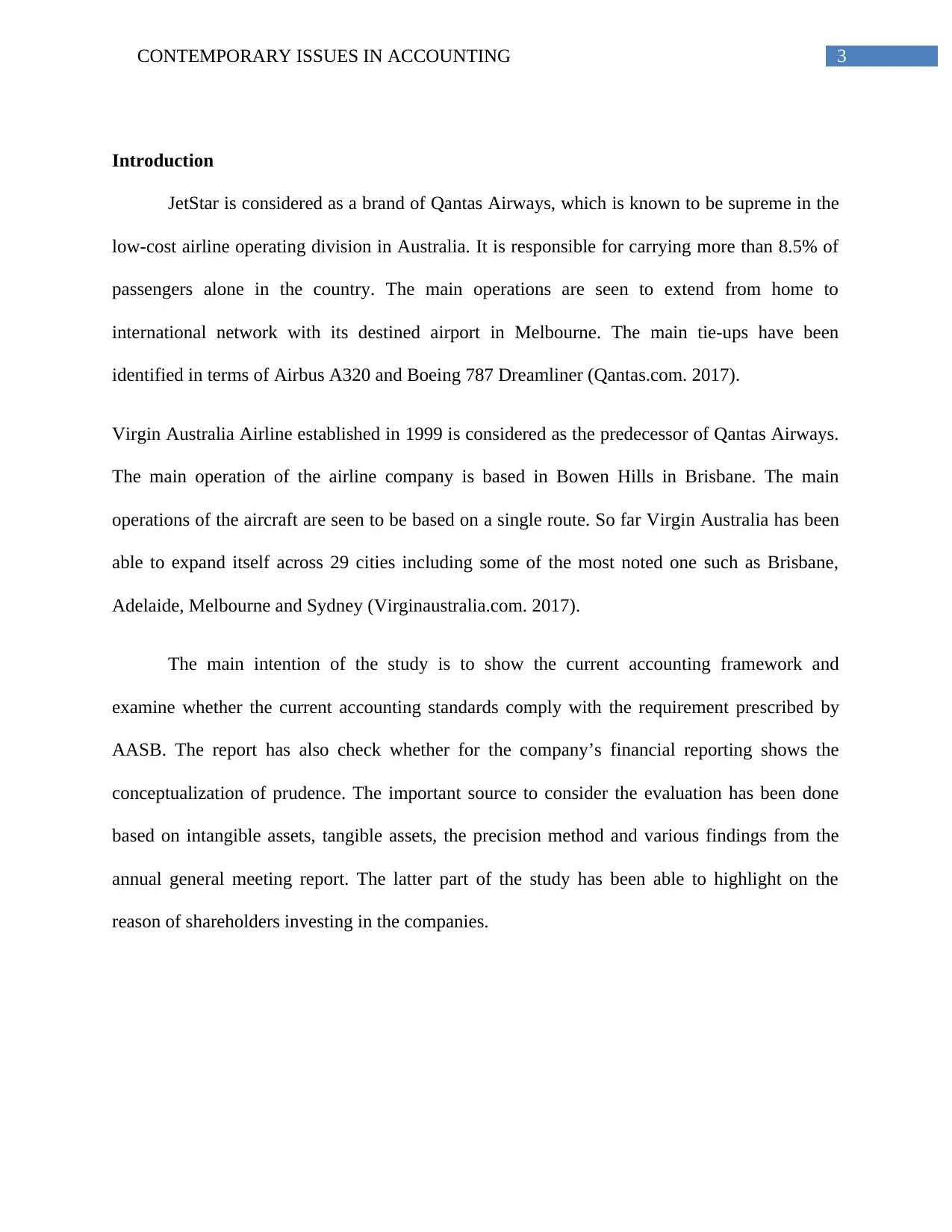
3CONTEMPORARY ISSUES IN ACCOUNTING
Introduction
JetStar is considered as a brand of Qantas Airways, which is known to be supreme in the
low-cost airline operating division in Australia. It is responsible for carrying more than 8.5% of
passengers alone in the country. The main operations are seen to extend from home to
international network with its destined airport in Melbourne. The main tie-ups have been
identified in terms of Airbus A320 and Boeing 787 Dreamliner (Qantas.com. 2017).
Virgin Australia Airline established in 1999 is considered as the predecessor of Qantas Airways.
The main operation of the airline company is based in Bowen Hills in Brisbane. The main
operations of the aircraft are seen to be based on a single route. So far Virgin Australia has been
able to expand itself across 29 cities including some of the most noted one such as Brisbane,
Adelaide, Melbourne and Sydney (Virginaustralia.com. 2017).
The main intention of the study is to show the current accounting framework and
examine whether the current accounting standards comply with the requirement prescribed by
AASB. The report has also check whether for the company’s financial reporting shows the
conceptualization of prudence. The important source to consider the evaluation has been done
based on intangible assets, tangible assets, the precision method and various findings from the
annual general meeting report. The latter part of the study has been able to highlight on the
reason of shareholders investing in the companies.
Introduction
JetStar is considered as a brand of Qantas Airways, which is known to be supreme in the
low-cost airline operating division in Australia. It is responsible for carrying more than 8.5% of
passengers alone in the country. The main operations are seen to extend from home to
international network with its destined airport in Melbourne. The main tie-ups have been
identified in terms of Airbus A320 and Boeing 787 Dreamliner (Qantas.com. 2017).
Virgin Australia Airline established in 1999 is considered as the predecessor of Qantas Airways.
The main operation of the airline company is based in Bowen Hills in Brisbane. The main
operations of the aircraft are seen to be based on a single route. So far Virgin Australia has been
able to expand itself across 29 cities including some of the most noted one such as Brisbane,
Adelaide, Melbourne and Sydney (Virginaustralia.com. 2017).
The main intention of the study is to show the current accounting framework and
examine whether the current accounting standards comply with the requirement prescribed by
AASB. The report has also check whether for the company’s financial reporting shows the
conceptualization of prudence. The important source to consider the evaluation has been done
based on intangible assets, tangible assets, the precision method and various findings from the
annual general meeting report. The latter part of the study has been able to highlight on the
reason of shareholders investing in the companies.
Paraphrase This Document
Need a fresh take? Get an instant paraphrase of this document with our AI Paraphraser
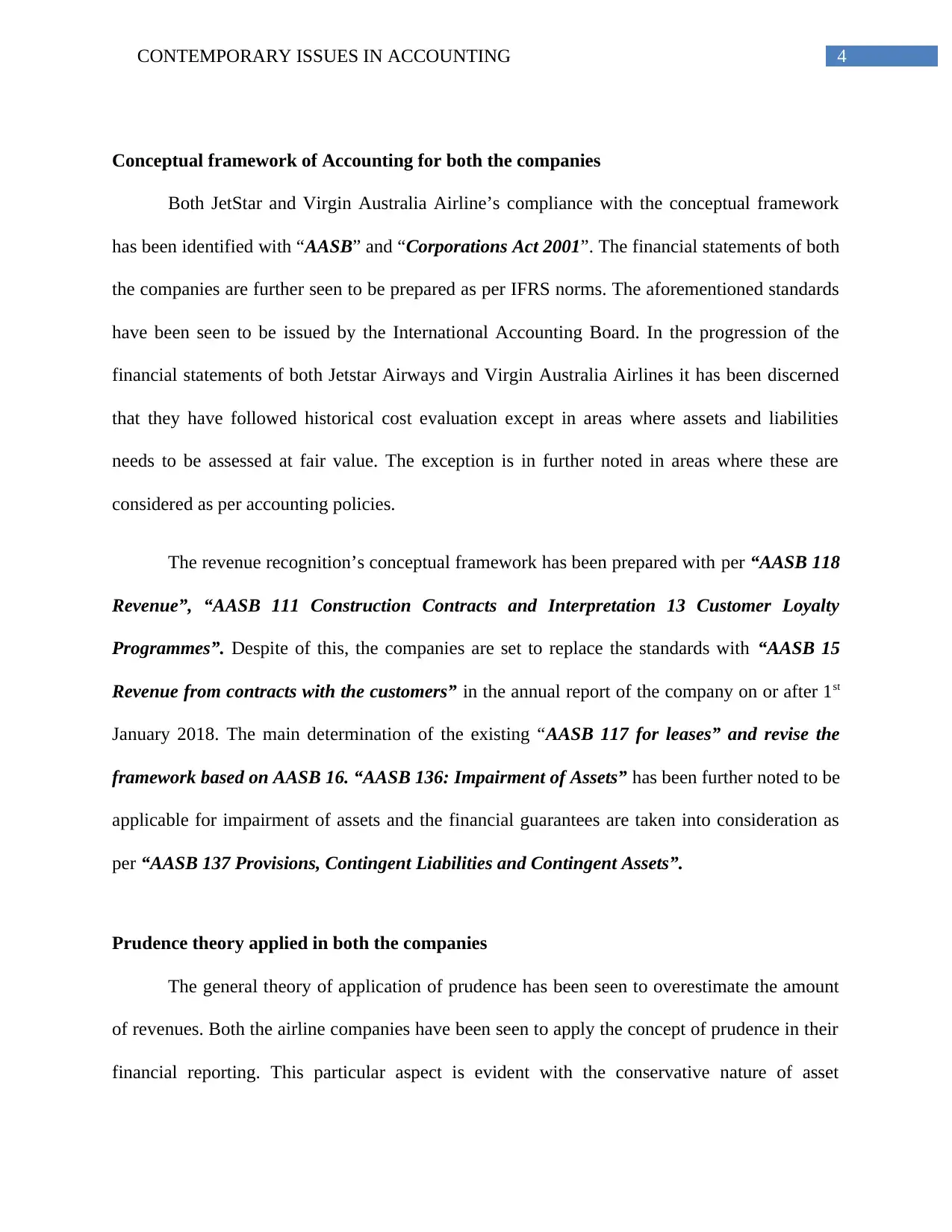
4CONTEMPORARY ISSUES IN ACCOUNTING
Conceptual framework of Accounting for both the companies
Both JetStar and Virgin Australia Airline’s compliance with the conceptual framework
has been identified with “AASB” and “Corporations Act 2001”. The financial statements of both
the companies are further seen to be prepared as per IFRS norms. The aforementioned standards
have been seen to be issued by the International Accounting Board. In the progression of the
financial statements of both Jetstar Airways and Virgin Australia Airlines it has been discerned
that they have followed historical cost evaluation except in areas where assets and liabilities
needs to be assessed at fair value. The exception is in further noted in areas where these are
considered as per accounting policies.
The revenue recognition’s conceptual framework has been prepared with per “AASB 118
Revenue”, “AASB 111 Construction Contracts and Interpretation 13 Customer Loyalty
Programmes”. Despite of this, the companies are set to replace the standards with “AASB 15
Revenue from contracts with the customers” in the annual report of the company on or after 1st
January 2018. The main determination of the existing “AASB 117 for leases” and revise the
framework based on AASB 16. “AASB 136: Impairment of Assets” has been further noted to be
applicable for impairment of assets and the financial guarantees are taken into consideration as
per “AASB 137 Provisions, Contingent Liabilities and Contingent Assets”.
Prudence theory applied in both the companies
The general theory of application of prudence has been seen to overestimate the amount
of revenues. Both the airline companies have been seen to apply the concept of prudence in their
financial reporting. This particular aspect is evident with the conservative nature of asset
Conceptual framework of Accounting for both the companies
Both JetStar and Virgin Australia Airline’s compliance with the conceptual framework
has been identified with “AASB” and “Corporations Act 2001”. The financial statements of both
the companies are further seen to be prepared as per IFRS norms. The aforementioned standards
have been seen to be issued by the International Accounting Board. In the progression of the
financial statements of both Jetstar Airways and Virgin Australia Airlines it has been discerned
that they have followed historical cost evaluation except in areas where assets and liabilities
needs to be assessed at fair value. The exception is in further noted in areas where these are
considered as per accounting policies.
The revenue recognition’s conceptual framework has been prepared with per “AASB 118
Revenue”, “AASB 111 Construction Contracts and Interpretation 13 Customer Loyalty
Programmes”. Despite of this, the companies are set to replace the standards with “AASB 15
Revenue from contracts with the customers” in the annual report of the company on or after 1st
January 2018. The main determination of the existing “AASB 117 for leases” and revise the
framework based on AASB 16. “AASB 136: Impairment of Assets” has been further noted to be
applicable for impairment of assets and the financial guarantees are taken into consideration as
per “AASB 137 Provisions, Contingent Liabilities and Contingent Assets”.
Prudence theory applied in both the companies
The general theory of application of prudence has been seen to overestimate the amount
of revenues. Both the airline companies have been seen to apply the concept of prudence in their
financial reporting. This particular aspect is evident with the conservative nature of asset
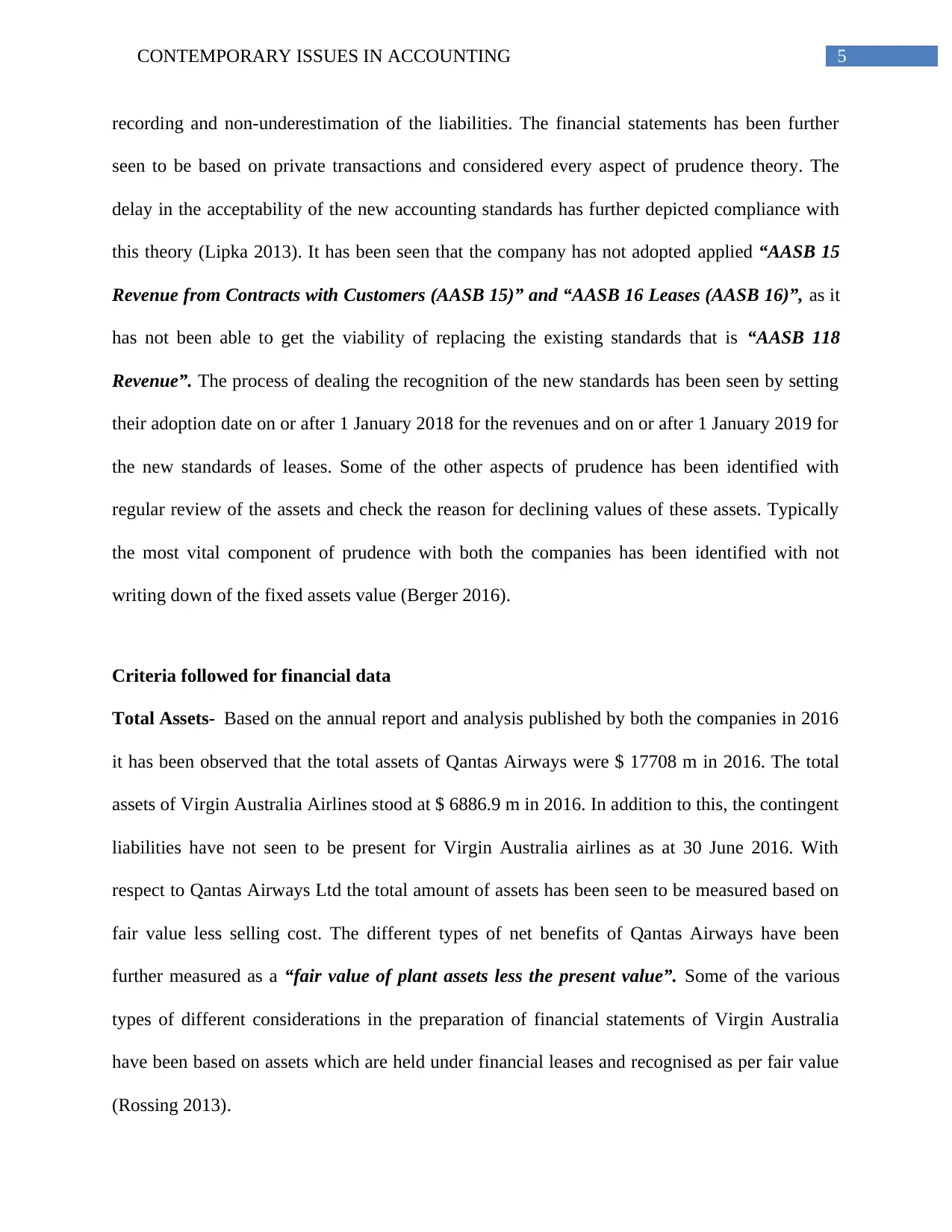
5CONTEMPORARY ISSUES IN ACCOUNTING
recording and non-underestimation of the liabilities. The financial statements has been further
seen to be based on private transactions and considered every aspect of prudence theory. The
delay in the acceptability of the new accounting standards has further depicted compliance with
this theory (Lipka 2013). It has been seen that the company has not adopted applied “AASB 15
Revenue from Contracts with Customers (AASB 15)” and “AASB 16 Leases (AASB 16)”, as it
has not been able to get the viability of replacing the existing standards that is “AASB 118
Revenue”. The process of dealing the recognition of the new standards has been seen by setting
their adoption date on or after 1 January 2018 for the revenues and on or after 1 January 2019 for
the new standards of leases. Some of the other aspects of prudence has been identified with
regular review of the assets and check the reason for declining values of these assets. Typically
the most vital component of prudence with both the companies has been identified with not
writing down of the fixed assets value (Berger 2016).
Criteria followed for financial data
Total Assets- Based on the annual report and analysis published by both the companies in 2016
it has been observed that the total assets of Qantas Airways were $ 17708 m in 2016. The total
assets of Virgin Australia Airlines stood at $ 6886.9 m in 2016. In addition to this, the contingent
liabilities have not seen to be present for Virgin Australia airlines as at 30 June 2016. With
respect to Qantas Airways Ltd the total amount of assets has been seen to be measured based on
fair value less selling cost. The different types of net benefits of Qantas Airways have been
further measured as a “fair value of plant assets less the present value”. Some of the various
types of different considerations in the preparation of financial statements of Virgin Australia
have been based on assets which are held under financial leases and recognised as per fair value
(Rossing 2013).
recording and non-underestimation of the liabilities. The financial statements has been further
seen to be based on private transactions and considered every aspect of prudence theory. The
delay in the acceptability of the new accounting standards has further depicted compliance with
this theory (Lipka 2013). It has been seen that the company has not adopted applied “AASB 15
Revenue from Contracts with Customers (AASB 15)” and “AASB 16 Leases (AASB 16)”, as it
has not been able to get the viability of replacing the existing standards that is “AASB 118
Revenue”. The process of dealing the recognition of the new standards has been seen by setting
their adoption date on or after 1 January 2018 for the revenues and on or after 1 January 2019 for
the new standards of leases. Some of the other aspects of prudence has been identified with
regular review of the assets and check the reason for declining values of these assets. Typically
the most vital component of prudence with both the companies has been identified with not
writing down of the fixed assets value (Berger 2016).
Criteria followed for financial data
Total Assets- Based on the annual report and analysis published by both the companies in 2016
it has been observed that the total assets of Qantas Airways were $ 17708 m in 2016. The total
assets of Virgin Australia Airlines stood at $ 6886.9 m in 2016. In addition to this, the contingent
liabilities have not seen to be present for Virgin Australia airlines as at 30 June 2016. With
respect to Qantas Airways Ltd the total amount of assets has been seen to be measured based on
fair value less selling cost. The different types of net benefits of Qantas Airways have been
further measured as a “fair value of plant assets less the present value”. Some of the various
types of different considerations in the preparation of financial statements of Virgin Australia
have been based on assets which are held under financial leases and recognised as per fair value
(Rossing 2013).
⊘ This is a preview!⊘
Do you want full access?
Subscribe today to unlock all pages.

Trusted by 1+ million students worldwide
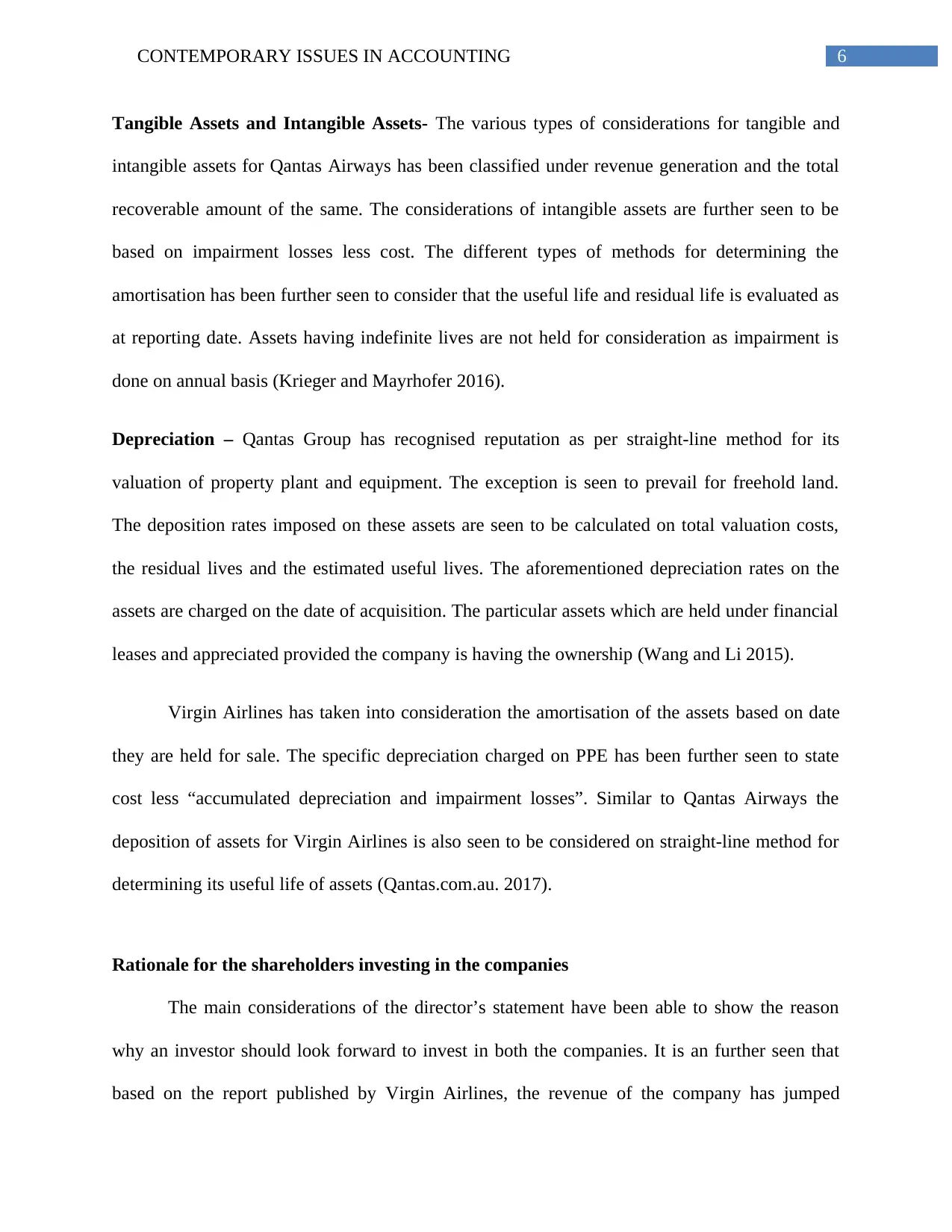
6CONTEMPORARY ISSUES IN ACCOUNTING
Tangible Assets and Intangible Assets- The various types of considerations for tangible and
intangible assets for Qantas Airways has been classified under revenue generation and the total
recoverable amount of the same. The considerations of intangible assets are further seen to be
based on impairment losses less cost. The different types of methods for determining the
amortisation has been further seen to consider that the useful life and residual life is evaluated as
at reporting date. Assets having indefinite lives are not held for consideration as impairment is
done on annual basis (Krieger and Mayrhofer 2016).
Depreciation – Qantas Group has recognised reputation as per straight-line method for its
valuation of property plant and equipment. The exception is seen to prevail for freehold land.
The deposition rates imposed on these assets are seen to be calculated on total valuation costs,
the residual lives and the estimated useful lives. The aforementioned depreciation rates on the
assets are charged on the date of acquisition. The particular assets which are held under financial
leases and appreciated provided the company is having the ownership (Wang and Li 2015).
Virgin Airlines has taken into consideration the amortisation of the assets based on date
they are held for sale. The specific depreciation charged on PPE has been further seen to state
cost less “accumulated depreciation and impairment losses”. Similar to Qantas Airways the
deposition of assets for Virgin Airlines is also seen to be considered on straight-line method for
determining its useful life of assets (Qantas.com.au. 2017).
Rationale for the shareholders investing in the companies
The main considerations of the director’s statement have been able to show the reason
why an investor should look forward to invest in both the companies. It is an further seen that
based on the report published by Virgin Airlines, the revenue of the company has jumped
Tangible Assets and Intangible Assets- The various types of considerations for tangible and
intangible assets for Qantas Airways has been classified under revenue generation and the total
recoverable amount of the same. The considerations of intangible assets are further seen to be
based on impairment losses less cost. The different types of methods for determining the
amortisation has been further seen to consider that the useful life and residual life is evaluated as
at reporting date. Assets having indefinite lives are not held for consideration as impairment is
done on annual basis (Krieger and Mayrhofer 2016).
Depreciation – Qantas Group has recognised reputation as per straight-line method for its
valuation of property plant and equipment. The exception is seen to prevail for freehold land.
The deposition rates imposed on these assets are seen to be calculated on total valuation costs,
the residual lives and the estimated useful lives. The aforementioned depreciation rates on the
assets are charged on the date of acquisition. The particular assets which are held under financial
leases and appreciated provided the company is having the ownership (Wang and Li 2015).
Virgin Airlines has taken into consideration the amortisation of the assets based on date
they are held for sale. The specific depreciation charged on PPE has been further seen to state
cost less “accumulated depreciation and impairment losses”. Similar to Qantas Airways the
deposition of assets for Virgin Airlines is also seen to be considered on straight-line method for
determining its useful life of assets (Qantas.com.au. 2017).
Rationale for the shareholders investing in the companies
The main considerations of the director’s statement have been able to show the reason
why an investor should look forward to invest in both the companies. It is an further seen that
based on the report published by Virgin Airlines, the revenue of the company has jumped
Paraphrase This Document
Need a fresh take? Get an instant paraphrase of this document with our AI Paraphraser
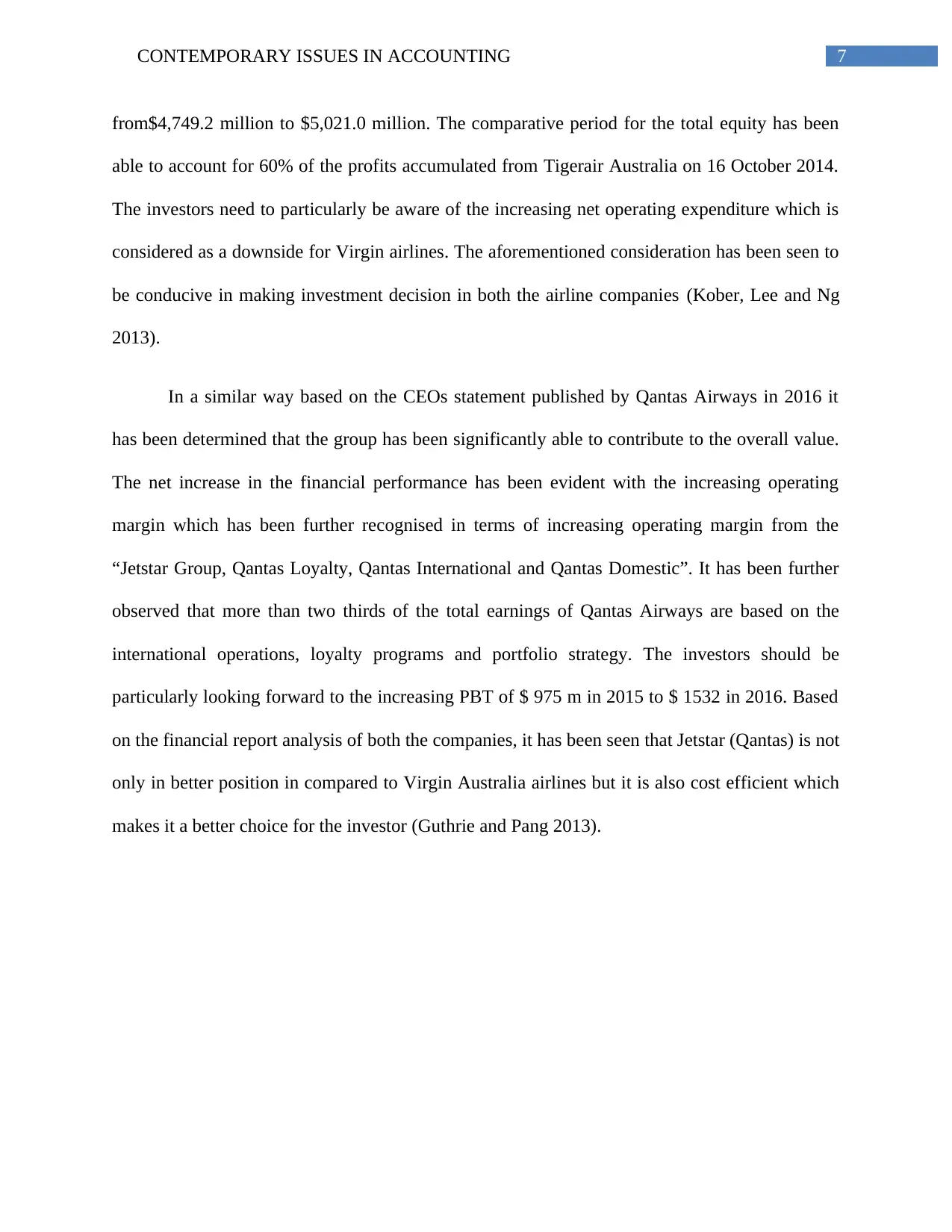
7CONTEMPORARY ISSUES IN ACCOUNTING
from$4,749.2 million to $5,021.0 million. The comparative period for the total equity has been
able to account for 60% of the profits accumulated from Tigerair Australia on 16 October 2014.
The investors need to particularly be aware of the increasing net operating expenditure which is
considered as a downside for Virgin airlines. The aforementioned consideration has been seen to
be conducive in making investment decision in both the airline companies (Kober, Lee and Ng
2013).
In a similar way based on the CEOs statement published by Qantas Airways in 2016 it
has been determined that the group has been significantly able to contribute to the overall value.
The net increase in the financial performance has been evident with the increasing operating
margin which has been further recognised in terms of increasing operating margin from the
“Jetstar Group, Qantas Loyalty, Qantas International and Qantas Domestic”. It has been further
observed that more than two thirds of the total earnings of Qantas Airways are based on the
international operations, loyalty programs and portfolio strategy. The investors should be
particularly looking forward to the increasing PBT of $ 975 m in 2015 to $ 1532 in 2016. Based
on the financial report analysis of both the companies, it has been seen that Jetstar (Qantas) is not
only in better position in compared to Virgin Australia airlines but it is also cost efficient which
makes it a better choice for the investor (Guthrie and Pang 2013).
from$4,749.2 million to $5,021.0 million. The comparative period for the total equity has been
able to account for 60% of the profits accumulated from Tigerair Australia on 16 October 2014.
The investors need to particularly be aware of the increasing net operating expenditure which is
considered as a downside for Virgin airlines. The aforementioned consideration has been seen to
be conducive in making investment decision in both the airline companies (Kober, Lee and Ng
2013).
In a similar way based on the CEOs statement published by Qantas Airways in 2016 it
has been determined that the group has been significantly able to contribute to the overall value.
The net increase in the financial performance has been evident with the increasing operating
margin which has been further recognised in terms of increasing operating margin from the
“Jetstar Group, Qantas Loyalty, Qantas International and Qantas Domestic”. It has been further
observed that more than two thirds of the total earnings of Qantas Airways are based on the
international operations, loyalty programs and portfolio strategy. The investors should be
particularly looking forward to the increasing PBT of $ 975 m in 2015 to $ 1532 in 2016. Based
on the financial report analysis of both the companies, it has been seen that Jetstar (Qantas) is not
only in better position in compared to Virgin Australia airlines but it is also cost efficient which
makes it a better choice for the investor (Guthrie and Pang 2013).
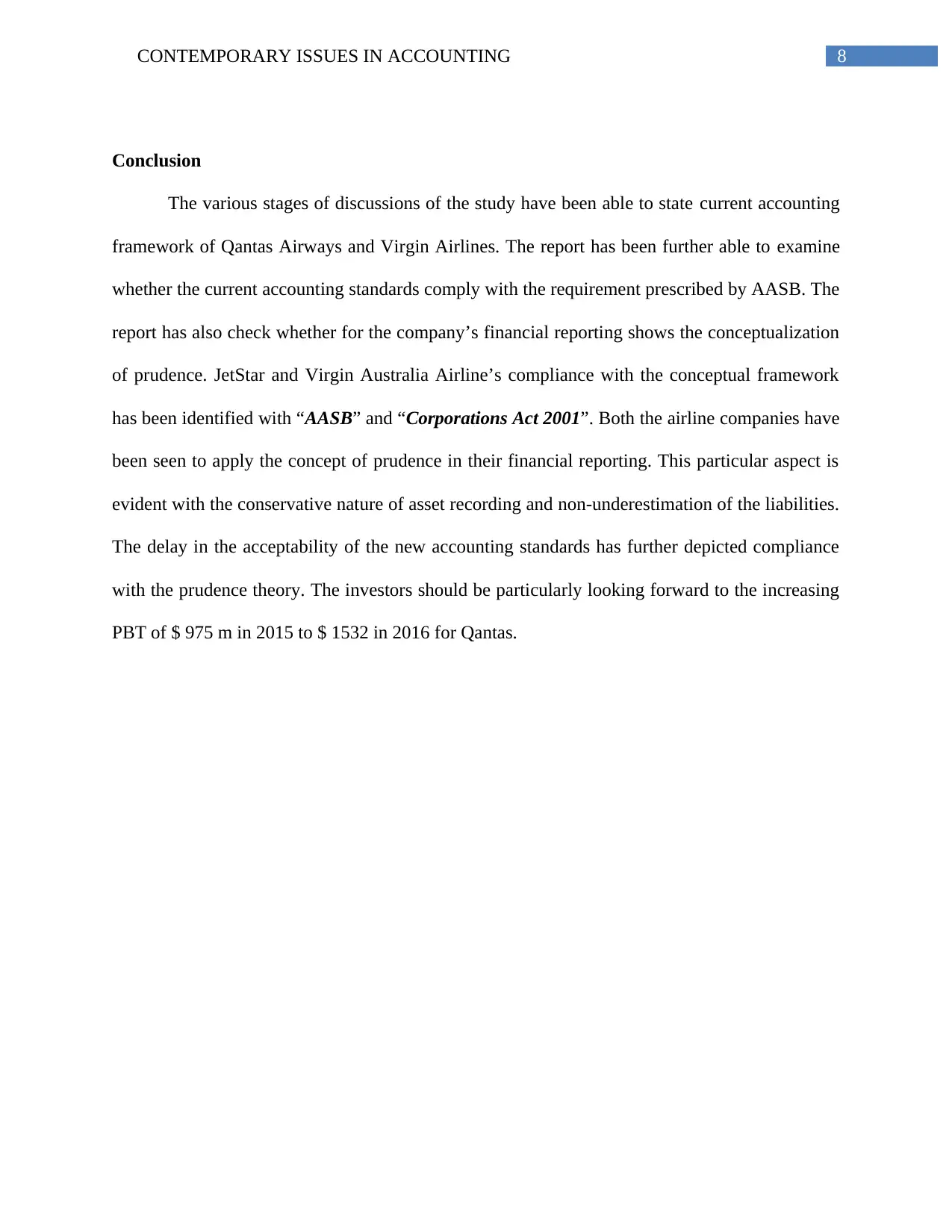
8CONTEMPORARY ISSUES IN ACCOUNTING
Conclusion
The various stages of discussions of the study have been able to state current accounting
framework of Qantas Airways and Virgin Airlines. The report has been further able to examine
whether the current accounting standards comply with the requirement prescribed by AASB. The
report has also check whether for the company’s financial reporting shows the conceptualization
of prudence. JetStar and Virgin Australia Airline’s compliance with the conceptual framework
has been identified with “AASB” and “Corporations Act 2001”. Both the airline companies have
been seen to apply the concept of prudence in their financial reporting. This particular aspect is
evident with the conservative nature of asset recording and non-underestimation of the liabilities.
The delay in the acceptability of the new accounting standards has further depicted compliance
with the prudence theory. The investors should be particularly looking forward to the increasing
PBT of $ 975 m in 2015 to $ 1532 in 2016 for Qantas.
Conclusion
The various stages of discussions of the study have been able to state current accounting
framework of Qantas Airways and Virgin Airlines. The report has been further able to examine
whether the current accounting standards comply with the requirement prescribed by AASB. The
report has also check whether for the company’s financial reporting shows the conceptualization
of prudence. JetStar and Virgin Australia Airline’s compliance with the conceptual framework
has been identified with “AASB” and “Corporations Act 2001”. Both the airline companies have
been seen to apply the concept of prudence in their financial reporting. This particular aspect is
evident with the conservative nature of asset recording and non-underestimation of the liabilities.
The delay in the acceptability of the new accounting standards has further depicted compliance
with the prudence theory. The investors should be particularly looking forward to the increasing
PBT of $ 975 m in 2015 to $ 1532 in 2016 for Qantas.
⊘ This is a preview!⊘
Do you want full access?
Subscribe today to unlock all pages.

Trusted by 1+ million students worldwide
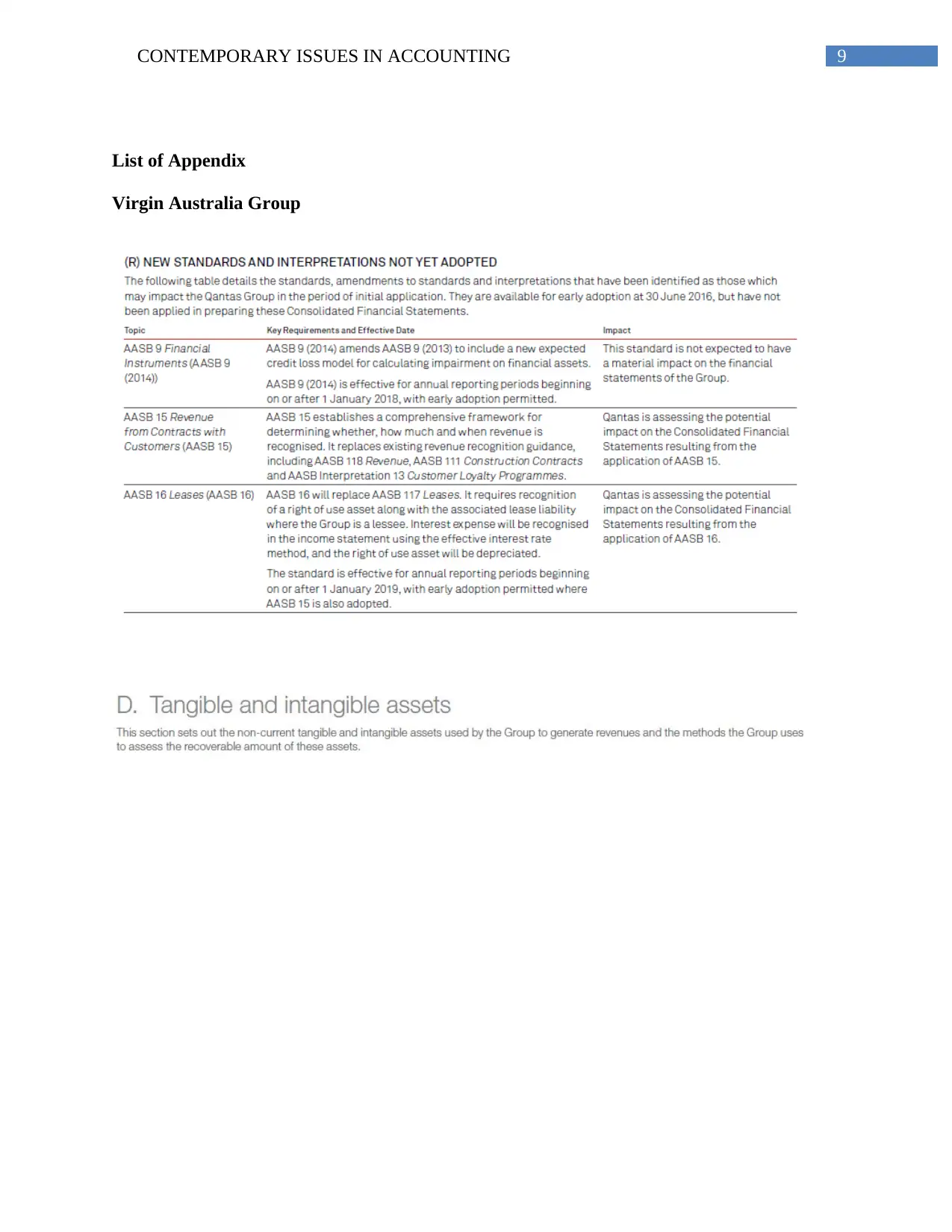
9CONTEMPORARY ISSUES IN ACCOUNTING
List of Appendix
Virgin Australia Group
List of Appendix
Virgin Australia Group
Paraphrase This Document
Need a fresh take? Get an instant paraphrase of this document with our AI Paraphraser
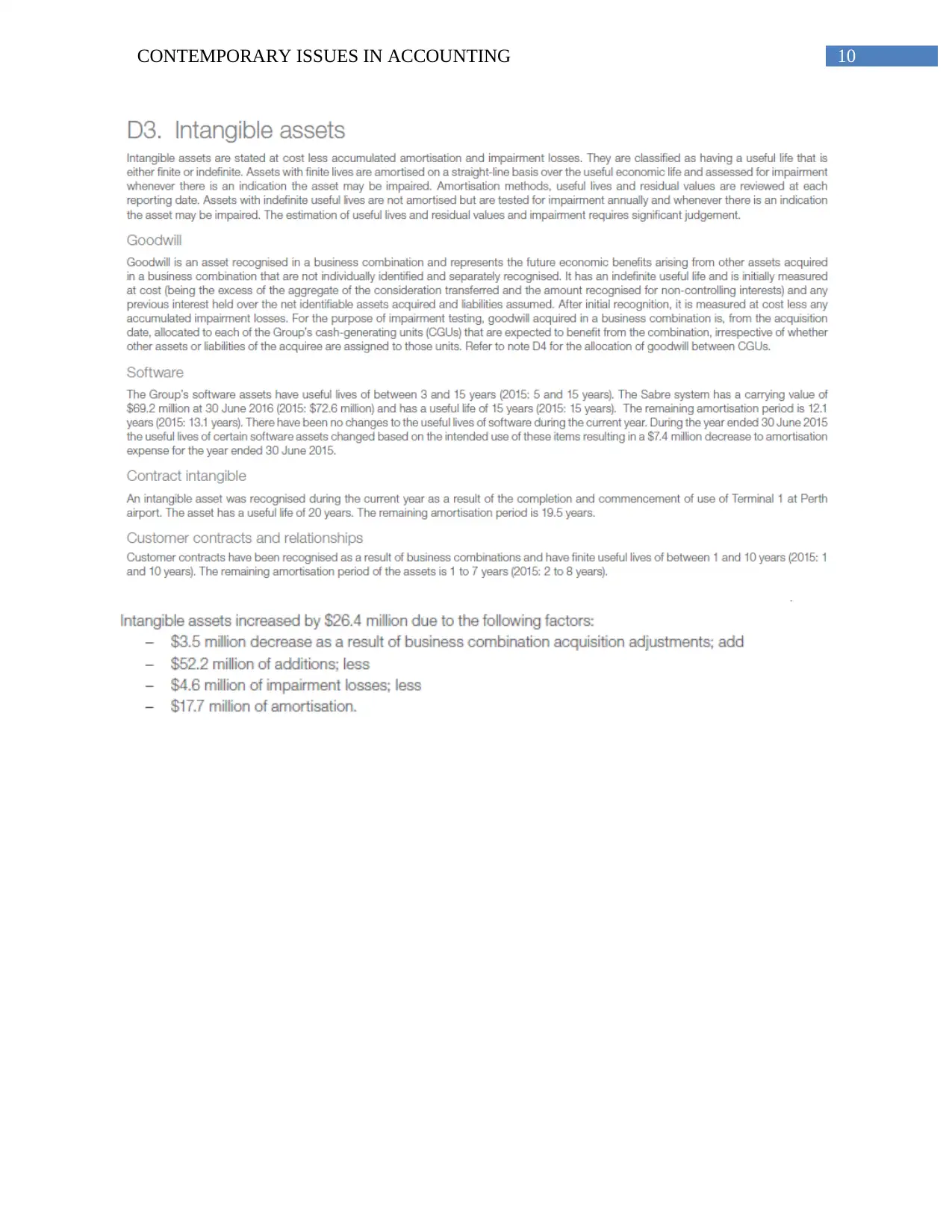
10CONTEMPORARY ISSUES IN ACCOUNTING
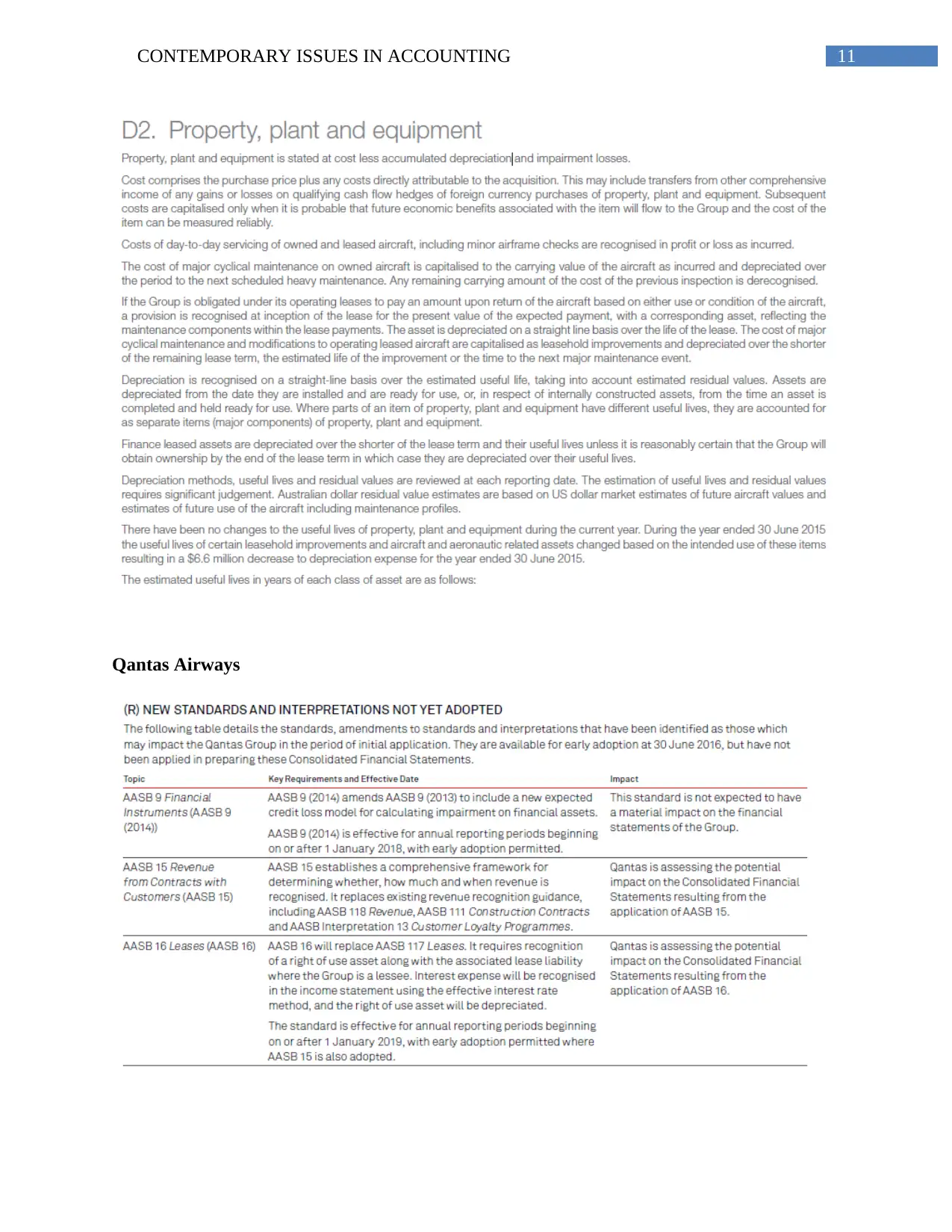
11CONTEMPORARY ISSUES IN ACCOUNTING
Qantas Airways
Qantas Airways
⊘ This is a preview!⊘
Do you want full access?
Subscribe today to unlock all pages.

Trusted by 1+ million students worldwide
1 out of 17
Related Documents
Your All-in-One AI-Powered Toolkit for Academic Success.
+13062052269
info@desklib.com
Available 24*7 on WhatsApp / Email
![[object Object]](/_next/static/media/star-bottom.7253800d.svg)
Unlock your academic potential
Copyright © 2020–2025 A2Z Services. All Rights Reserved. Developed and managed by ZUCOL.




